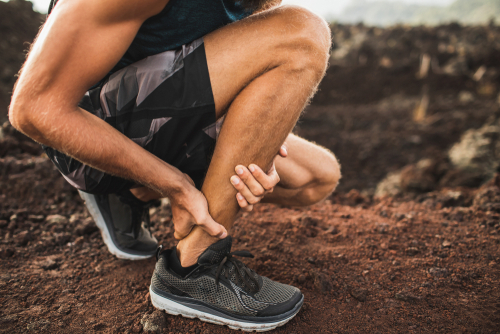DOES THE BACK OF YOUR HEEL HURT WHEN YOU RUN?
So far, we’ve had three articles in our running injury series. We’ve shared about patellofemoral pain (anterior knee pain), ITBS (Iliotibial Band Syndrome) and plantar fasciitis (heel pain). Another common complaint by the running community is heel pain due to achilles tendinitis.
WHAT IS ACHILLES TENDINITIS?
To better understand achilles tendinitis, let’s look at the anatomy. The achilles (or heel cord) is a prominent tendon on the back of the leg. It connects the 2 calf muscles, the gastrocnemius and soleus to the back of the heel (see picture). When the calf muscles contract, they cause the foot to point downward. This enables you to push off when you walk and run. The gastrocnemius also assists with bending of the knee.

“Itis” means “inflammation of”. Achilles tendinitis is defined as inflammation of the achilles tendon. Symptoms of achilles tendinitis include pain to the back of the heel. It’s normally about an inch above the heel and less frequently lower at the insertion of the tendon into the heel. It is palpably tender and there may be swelling to the tendon. Pain worsens during push off and when taking the first few steps after getting out of bed or after prolonged sitting. The pain is most pronounced at the start of exercise and usually lessens during the activity but worsens after completion. The onset is usually gradual.
If the inflammation persists, there will be changes to the collagen make-up of the tendon. It will become a tendinosis. The “osis” means chronic degeneration of a tendon without inflammation”. The treatment for a tendinitis versus a tendinosis will be different.
WHY DO RUNNERS GET ACHILLES TENDINITIS?
There are many reasons runners may develop achilles tendinitis. Below are some of the more common causes:
- Excessive pronation: The easiest way to explain pronation is to look at the arch of your foot. When standing, does your arch collapse? Some runners have problems with their arch collapsing too much. (see picture).

Your foot should roll in slightly when you run to give you shock absorption. But if it is excessive or occurs at the wrong time, it will cause the arch to collapse excessively. When this happens, the achilles tendon will go through an excessive range of motion. During each step it can cause a twisting to the tendon. This stress may predispose the tendon to injury. Some causes of excessive pronation may be anatomical structure, calf tightness or hip/glute weakness.
- Decreased calf strength: Decreased calf strength puts greater stress on the achilles tendon.
- Training errors: One training error is attempting to increase mileage too quickly. Another is running hills. Both can cause achilles tendinitis.
HOW DO YOU MANAGE ACHILLES TENDINITIS?
If your pain is fairly new, it is likely still a tendinitis. Treatment options for achilles tendinitis include:
- Ice
- Anti-inflammatories
- Heel lift to reduce stress to achilles tendon
- Taping to reduce excessive pronation
- Over the counter orthotics can help reduce excessive pronation.
- Rest from aggravating activities
HOW DO YOU MANAGE ACHILLES TENDINOSIS?
If you have had your pain for a longer time, it may have developed into a tendinosis. Achilles tendinosis is less likely to respond to the treatment above. Treatment for a tendinosis may include:
- Cross friction massage: Using your finger, find the tender spot on your achilles and begin massaging that area. Make sure you are perpendicular to the line of the fibers. Your finger should move horizontally. Keep your finger in contact with the sore area and do not slide your finger on your skin. This will cause soreness, but will help improve blood flow and stimulate collagen reformation.
- Calf stretching: It is important to make sure your calves are flexible. Below are pictures on proper ways to stretch your gastrocnemius and soleus.


- Eccentric loading: Eccentric loading is a calf strengthening program. Its purpose is to realign the fibers of the achilles and improve blood flow within the tendon. Eccentrics have been found to be very effective for achilles tendinosis. Below is how to perform these exercises (see picture). Perform 3 sets of 25 repetitions once a day for 12 weeks. It may cause discomfort when performing initially, but this pain should lessen as the days progress.


Raise onto toes on both feet. When reaching the top, remove the uninvolved foot and lower down with the involved foot slowly throughout the full motion. Then raise again on both feet and lower on one.
- Heel lift: Heel lift is used to reduce stress to achilles tendon.
- Over the counter orthotics: If you pronate excessively, over the counter orthotics may help. They control this excessive motion and reduce stress to the achilles.
- Night splint: Night splints will hold your calf in a slightly stretched position. It will reduce the discomfort when getting out of bed and taking the first few steps of the day.
WHAT IF YOU ARE UNABLE TO GET YOUR ACHILLES BETTER???
If you have not had success with any of the suggested treatment options, you may benefit from visiting a professional. See someone who understands how to treat achilles tendinitis in the running population. They should understand running mechanics and have the ability to videotape and analyze your running mechanics in order to determine what is responsible for the continued achilles pain. In the state of Virginia, most insurances allow you to visit a physical therapist WITHOUT seeing a doctor first. Reach out to your local therapist and find out if they are a good fit.

